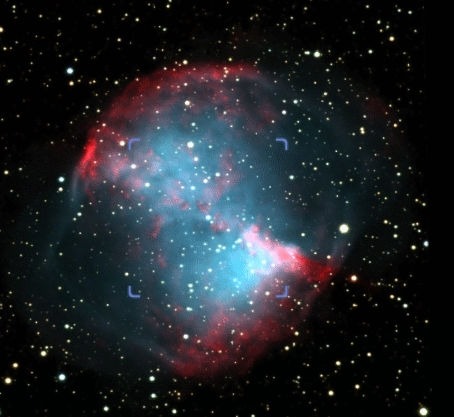Planetary Nebulae
Planetary nebulae make some of the most pleasing sights in a small telescope.
They also provide spectacular photographs.

Ring Nebula, M57, in Lyra
Credit: NASA, ESA, and C. Robert O’Dell (Vanderbilt University).
In this blog we’ll pick out some notable planetary nebulae.
If you have a telescope, you may be able to observe them.
What are planetary nebulae?
A misnomer
Planetary nebulae have nothing to do with planets.
The misnomer arose in the 18th Century.
In early telescopes, astronomers discovered dim round objects.
They resembled planets but were not distant worlds.
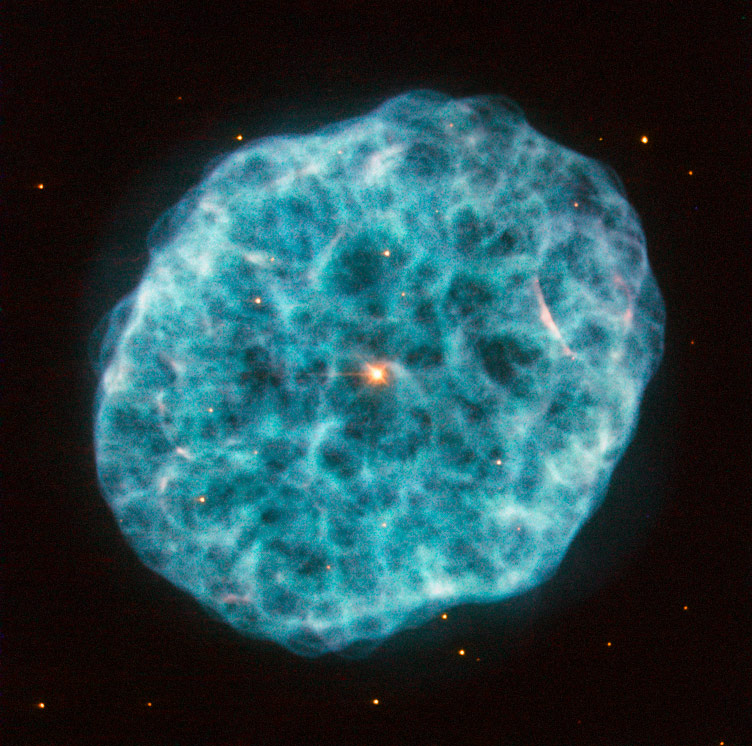
Planetary nebula NGC 1501, the Oyster Nebula
Credit: ESA/Hubble & NASA, Acknowledgement: Marc Canale
William Herschel, discoverer of Uranus, described the nebulae as planet-like in shape.
The name stuck and is still being used.
True Nature
A planetary nebula marks the end of a star’s life.
In a previous blog we showed how dying stars swell up to become red giants.
Red giant stars continue to grow.
Eventually they blow away their outer layers in an expanding ball of hot gas.
This ball of gas is the planetary nebula.
At the centre of the nebula is a remnant, a dead star.
It is the old core of the star.
It is a white dwarf, a stellar corpse which will gradually fade into cold darkness.
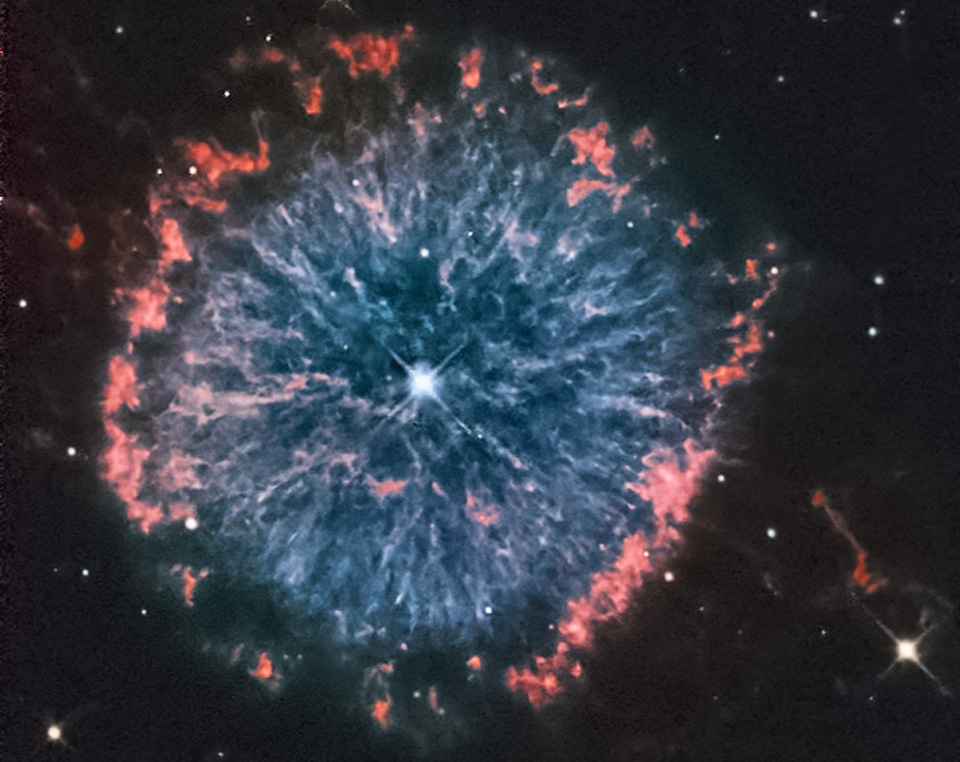
NGC 6751, Glowing Eye Nebula and central white dwarf
Credit: Hubble Legacy Archive / NASA / ESA / Donald Waid
Discovery
Charles Messier, a French comet hunter, made the first discovery in 1764.
He entered it in his catalogue of nebulae as M27.
It’s now known as the Dumbbell Nebula.
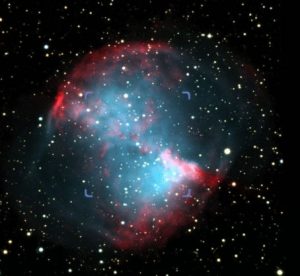
Dumbbell Nebula, M27, Stellarium
A century passed before astronomers got close to the nature of planetaries.
In 1864, William Huggins used a spectroscope to study the Cats Eye nebula.
He found that it was made of hot gas.

Cat’s Eye nebula
Credit: NASA, ESA, HEIC, and The Hubble Heritage Team (STScI/AURA)
Later spectroscopic studies showed that the gas was expanding outwards.
Astronomers realised that a dying star’s outer layers were being released into space.
Planetary nebulae do not last very long in cosmic terms.
After around 10,000 years the expanding gas is so spread out that it becomes invisible.
All that’s left is the hot white dwarf.
NASA have recently produced a novel view of the Cat’s Eye Nebula.
It comes with sound that picks out gas shells and jets.
To see and hear it, click here.
Features
The average planetary nebula is about 1 light year across.
That’s around 9 million, million kilometres.
The temperature of the expanding gas shell varies with distance.
Close to the white dwarf it’s around 25,000 C.
Towards the edge the temperature drops to 10,000 C.

Bubble nebula. Credit: NASA / ESA / HST
Many planetaries are more or less circular in appearance.
They are spherical bubbles of expanding gas.
But some have irregular shapes.
Recent research suggests that the dying star’s magnetic fields might play a part in shaping the nebula.

NGC 5189
Credit: NASA, ESA and the Hubble Heritage Team (STScI/AURA)
Cosmic recycling
Planetary nebulae play an important role in the evolution of galaxies.
During the red giant phase, stars turn hydrogen into heavier elements.
Among them are carbon, oxygen and nitrogen.
The planetary nebula carries these new materials into space.
They form dust which can eventually form planets around a new generation of stars.
Two Planetary nebulae for You
I’ve chosen two planetary nebulae that you can observe with a small telescope.
Both are in the summer sky, looking south.
Both lie inside the Summer Triangle of stars.
The triangle is made up of Vega, Deneb and Altair.
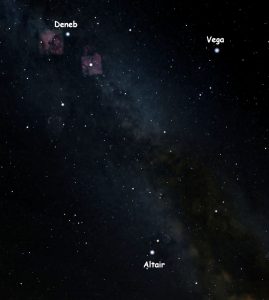
Summer Triangle, Stellarium
M27, Dumbbell Nebula
Our first target is the first planetary nebula to be discovered.
It’s M27, the Dumbbell.
Look above Altair, the bottom star of the triangle.
You will see a dart shape of four stars.
This is Sagitta the Arrow.
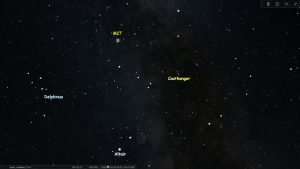
Location of M27, Stellarium
Above the point of the arrow is the Dumbbell Nebula.
You can see the reason for it’s name.
It has two lobes like a dumbbell.

M57, Ring Nebula
The Dumbell is quite a large planetary.
It lies 1300 light years away.
Our next target is much smaller but brighter.
It’s the Ring nebula, M57.
M57 is around 2,600 light years away, twice as far as M27.
Find the star Vega at the top right of the triangle.
Below Vega is a trapezium of 4 stars.
The Ring lies between the two bottom stars of the trapezium.
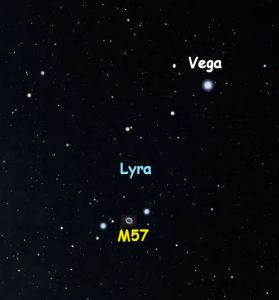
Location of M57. Stellarium
These nebulae appear grey monochrome through a telescope.
Their colours can only be seen in long exposure photographs.
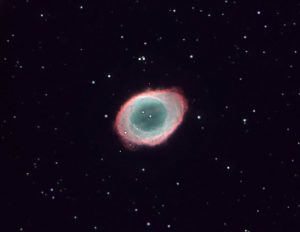
M57, Ring Nebula. Stellarium
Ashes to Ashes
As stars die, fusion reactions in their cores convert hydrogen into heavier elements.
They include carbon, nitrogen and oxygen.
These are the basic elements of life.
4.6 billion years ago, these elements became part of the young Earth.
Some of those atoms are in your body right now.
We are all made of stardust.
Five billion years from now, the Sun will become a dying red giant.
Then it will blow away its outer layers.
The Sun will become a new planetary nebula.
The Earth will be destroyed.
Its atoms will be blown into space.
The atoms now in your body will be among them.
You will return to dust.
Ashes to ashes, stardust to stardust.

The author: Dennis Ashton is a Fellow of the Royal Astronomical Society and a Wonderdome presenter.
Would you like to hear more Astronomy news?
Do you want to to find out about our upcoming public events?
Follow WonderDome Portable Planetarium on Twitter and Facebook or go to our web site wonderdome.co.uk

